Elizabeth Kolbert has a son who should be studying for the SATs. In a edition to this history below, she offers her thoughts (mostly negative) on what the test doesn't do: test cognitive skills and imagination.
“The SATs were administered for the first time on June 23, 1926. Intelligence testing was a new but rapidly expanding enterprise; during the First World War, the United States Army had given I.Q. tests to nearly two million soldiers to determine who was officer material. (Walter Lippmann dismissed these tests as “quackery in a field where quacks breed like rabbits.”) The SAT’s inventor, a Princeton professor named Carl Campbell Brigham, had worked on the Army’s I.Q. test, and the civilian exam he came up with was a first cousin to the military’s. It contained some questions on math and some on identifying shapes. Mostly, though, it focussed on vocabulary. Brigham intended the test to be administered to students who had already been admitted to college, for the purposes of guidance and counselling. Later, he argued that it was foolish to believe, as he once had, that the test measured “native intelligence.” Rather, he wrote, scores were an index of a person’s “schooling, family background, familiarity with English, and everything else.”
By this point, though, the test had already been adopted for a new purpose. In 1933, James Bryant Conant, a chemist, became the president of Harvard. Conant, the product of a middle-class family, was dismayed by what he saw as the clubbiness of the school’s student body and set out to attract fresh talent. In particular, he wanted to recruit bright young men from public schools in the Midwest, few of whom traditionally applied to Harvard. Conant’s plan was to offer scholarships to ten such students each year. To select them, he decided to employ the SAT. As Nicholas Lemann observes in his book “The Big Test” (1999), this was one of those small decisions “from which great consequences later flow.” Not long after Harvard started using the SAT, Princeton, Columbia, and Yale followed suit. More and more colleges adopted the test until, by the mid-nineteen-fifties, half a million kids a year were taking it.”
Thank goodness I took the older version. I'm going to hate it when my son has to take it.
